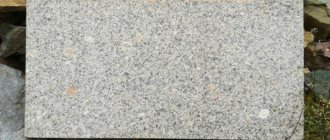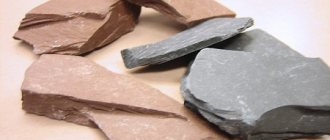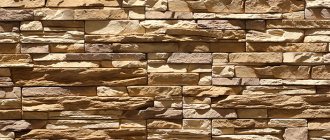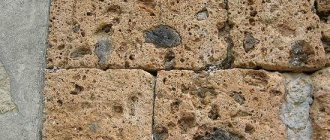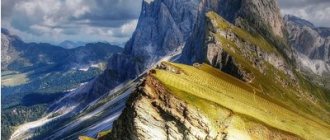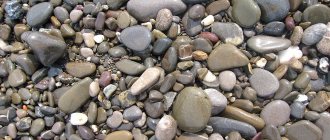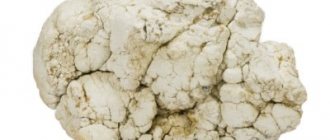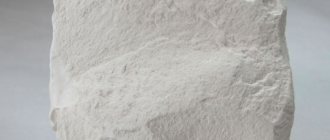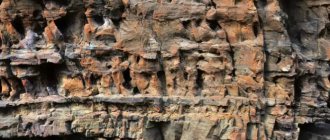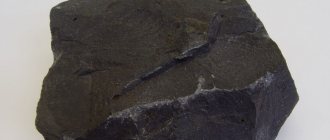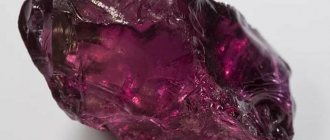And the city, and the stone, and the shoes... And it seems that these words have nothing in common, but this is a deceptive statement. “I’m in Slantsy, I’m going for shale in Slantsy!” - exclaimed a resident of the city of the same name, walking to a hardware store in flip-flops. Well, if they know about the famous city in which shoes were made for the Soviet Union, not many have heard about the slate rocks.
Natural slate
History of the stone
The word slate is formed not from the verb to send, as can rightly be noted, but from lay, lay. In the old days, this is what they called schist... Schists are a metamorphic (altered) rock formed during the Ordovician period 500 million years ago, formed from dark-colored minerals, feldspar or quartz. The concept of metamorphism is the change under pressure and temperature of an existing rock in the depths of the earth's crust in an environment of gases and aqueous solutions due to volcanic and tectonic processes. Increasing temperature accelerates chemical reactions, promotes recrystallization, increases porosity and thus permeability to various minerals and fluids. The result is a rock that shimmers in the sun.
Some information about the breed
Slate is a fine-grained, layered metamorphic rock that was formed by regional metamorphism. This stone is distinguished by its structural uniformity and beauty, it has a long service life of more than 300 years.
The mineral composition of slate varies greatly from place to place, but the main constituents of all varieties are white and black mica.
Due to its characteristics, it can be divided into smooth sheets. High strength and water resistance make this type of stone one of the most durable and versatile finishing materials.
What does it look like
Natural slate is a rock with a schistose structure. According to the established rule, the name is given according to the rock-forming minerals according to the 1-2-3 scheme. The mineral that is the least abundant in a mineral and becomes the first in the name:
- chlorite – chlorite, epidote, quartz;
- garnet - garnet, quartz, feldspar.
In general, the color of the stone is varied, with pronounced shades, mainly depending on the host minerals. The most common are gray and black. The black color has a graphite tint with a matte sheen, while the gray one has an oily sheen predominates.
Black slate
Slate multicolor
Gray slate
Slate black graphite
Natural burgundy slate
Varieties
The breed is diverse, so it was ordered by structure and composition.
All shales are divided into clayey and crystalline.
Clays are almost always dark gray or green. Compacted clay contains fragments of quartz, sulfur pyrites, rutile, feldspar, mica, and other minerals.
Based on their structure, description, and physical characteristics, the following types of shale are distinguished:
- Slate. A soft stone of gray shades, easy to flake. This is the core of ordinary pencils.
- Combustible. It looks like dense clay, easily ignites, and is in demand as fuel.
- Alum stone is saturated with sulfur pyrites.
- Siliceous. Dense multi-colored plates interspersed with quartz and chalcedony grains.
- Mica. A stone with mica and quartz as its main components. A special case is biotite shale (with black mica called biotite).
- Grinding. A greenish, very hard variety with a high percentage of silica.
- Chlorite. The main impurity - chlorine - creates green shades of stone with shine.
The durable layered texture has made black slate and gray roofing slate popular construction and technical materials.
A separate variety is considered to be a stone of artificial origin.
Physico-chemical characteristics and varieties
More than 3 thousand mineral agglomerates are known in the world. For description and classification, a diagnostic technique based on physical, mechanical and chemical properties is used. This is necessary for an unambiguous identification of a particular mineral resource. Physical characteristics mean:
- optical:
- color;
— transparency;
- shine;
- mechanical:
— hardness;
- cleavage;
- special (the ability to deflect a magnetic needle, a characteristic garlic smell after rubbing, plasticity and others).
To further understand the concept of rock hardness, it is useful to become familiar with the Mohs scale, named after the 18th-19th century German mineralogist and geologist.
| Name of mineral | Appearance | Hardness | Machinability |
| Talc | 1 | Nail scratches remain | |
| Gypsum | 2 | Nail scratches remain | |
| Calcite | 3 | Traces of a copper coin remain | |
| Fluorite | 4 | Scratched by a steel nail or glass shard | |
| Apatite | 5 | Scratched by a steel nail or a piece of glass, but only with force | |
| Orthoclase | 6 | Mineral scratches glass, can be processed with a file | |
| Quartz | 7 | Processed with diamond, leaves scratches on glass | |
| Topaz | 8 | Processed with diamond, leaves scratches on glass | |
| Corundum | 9 | Processed with diamond, leaves scratches on glass | |
| Diamond | 10 | Cuts glass |
Let's consider the properties of slates, which have become widespread in industrial sectors, construction and decorative crafts.
- Clayey is a hard rock with a cryptocrystalline structure from gray to reddish in color with a matte sheen. It has a variety of shades and color saturation. Consists mainly of clay minerals, hardness 2-4 (slips on glass without leaving scratches). In rare cases, the presence of quartz may leave scratches. The presence of carbonate inclusions (calcite, marl, dolomite) is indicated by a chemical reaction with hydrochloric acid. The strength characteristics are significantly influenced by schistosity and cracks. The strength is low, it breaks easily along the schistose plane, varies from 20 MPa for talc and chlorite schists to 100-200 MPa for mica schists, however, for clayey schists the figure is less than 20 MPa. Almost all samples are anhydrous. According to the composition of minerals, they are divided into: – calcareous – contains calcite (5-22%), enters into a chemical reaction when exposed to hydrochloric acid; – siliceous-clayey – contains silica, is quite strong and hard; – roofing – capable of stratification into small-thick solid plates; – graphite – grayish, due to graphite crystals it leaves a line on the surface of the paper, dirtying your hands, tactilely greasy and soft; – bituminous – due to the presence of bitumen in the composition – black. When heated, a specific smell appears; – carbonaceous – black in color, draws on paper, but weakly. Hardness is low.
- Mica slate. It mainly contains various micas, hence the name. The color varies and is due to the micas contained in the rock. Includes sericite (thin scales), biotite, muscovite (light color). Forms a silky pearlescent sheen, sometimes silvery with a coarse-scale structure. The main difference from other types is the greater presence of mica relative to quartz. According to the composition of minerals it is divided into: – biotite (black shale); – muscovite (light); – double mica (same muscovite-biotite ratio); – mica-chlorite (difference from other varieties – the presence of chlorite, has a greenish color). – sericite is represented by sericite flakes, light gray in color with greenish inclusions. Clay mineralization is minimal. Hardness 3 (scratches plaster).
- The slate is nodular. Sometimes called mottled due to its texture and presence of mineral inclusions (spots). Color with a wide range, from dark gray to brown. Cryptocrystalline structure with mineral inclusions in the node zone. Pronounced mottled texture. Clay minerals interspersed in hematite and magnetite nodes are rock-forming. Stone samples react to a magnetic needle.
- Talc slate. It got its name because of its slate-like structure and the predominant presence of talc. A white, sometimes yellowish rock with a fine-grained structure, consisting of talc (greasy, leaves fingernail marks), quartz (scratches glass), and inclusions of calcite and chlorite (greenish color). Distinctive feature – soft, hardness on the scale – 2.
- Chlorite shale. It owes its name due to its schistosity and chlorite content. There is a beautiful green slate shimmering in the sun. With a cryptocrystalline structure, crystals of ore inclusions are often visible. Contains talc and chlorite and has a slightly greasy feel. Hardness value - 2.5. If there is more talc, then the shale is chlorite-talc, if there is mica, then it is chlorite-mica.
There are also oil shale, but we’ll talk about them a little later.
Properties and applications of slate
The breed is used in various industrial fields. This is due to the large number of varieties, physical and chemical properties of the stone. Main areas of application:
- construction;
- interior decoration;
- roofing;
- making dishes;
- landscape design;
- use as fuel.
View this post on Instagram
Posted by STONEHOME l Volgograd (@stonehome34) Jun 19, 2022 at 11:32 PDT
In repair and decoration
Stone in its original form is a ready-made building material. In the construction industry, slate has certain advantages:
- Slate roofs are durable. They never leak or fade in the sun.
- Stones are immune to cold weather. They retain heat perfectly, which allows them to be used for constructing the walls of houses in areas with harsh climates.
- Designers often use slate in interior design. The mineral is used to line fireplaces, walls, columns, and floors.
Crystalline minerals are best suited for cladding. Its blocks are reliable and durable. They retain heat well and insulate sound.
Artificial stone is well suited for construction work. It has a varied color palette, is almost indistinguishable from natural in appearance, is affordable, but less reliable.
View this post on Instagram
Posted by Natural Stone 47 (@_naturalstone47_) Jun 24, 2019 at 1:20 PDT
View this post on Instagram
Posted by Natural Stone 47 (@_naturalstone47_) Jul 4, 2019 at 2:53 PDT
View this post on Instagram
Posted by Natural Stone 47 (@_naturalstone47_) Jun 26, 2019 at 10:44 am PDT
Physicochemical characteristics
Slate is distinguished from other stones by the features of its structure and chemical composition:
- The chemical composition is determined by the ratio of oxides: SiO2 from 15 to 25%, Al2O3 from 55 to 75%, Fe2O3 up to 4%, CaO up to 6%, TiO2 up to 1%, MgO up to 6%.
- Hardness: 3–6 on the Mohs scale.
- Density – 2.71 g/cm3.
- In nature it is found in a variety of shades: yellow, red, brown, burgundy, green. But the most common specimens are found in black and gray colors.
- Resistant to corrosion and erosion.
- Oily or matte shine, depending on the variety.
View this post on Instagram
Publication from gib-kam.ru (@gib_kam.ru) June 23, 2022 at 10:38 PDT
Medicinal properties
The natural energy of slate has some healing effects on humans. The mineral has a positive effect on overall health, making you feel more alert and energetic. Lithotherapists note other beneficial properties of the stone:
- The stone has a beneficial effect on the nervous system, relieves stress and tension. Helps overcome irritation and anger.
- Water charged with a stone can cleanse the body, prevent various diseases, and encourage positive thinking.
- If you heat the mineral and apply it to a sore spot or wound, the pain and inflammation will go away, and healing will proceed faster.
It is useful to be in a building with walls lined with slate. Living in such a house will allow you to never experience difficulties with your health and emotional state.
Magic properties
The breed is often used in magical rituals of shamans and sorcerers. They use it to tell fortunes or to contact the spirits of the underworld.
In everyday life, the aura of a stone can help a person in his affairs and transform his life for the better.
Among the mystical qualities of slate are:
- The stone helps mental wounds heal.
- Works as a talisman, removing evil and failure from the owner.
- Suitable for any zodiac sign, except Aries and Capricorn, as an amulet. The mineral will prompt you to the right decision and will help you achieve your goals soon.
- Talismans attract luck and money.
Places and methods of extraction
The main large deposits of shale minerals are located in Russia (Caucasus, Urals, Altai Territory), USA, Germany, France and Spain. Claystones are mined in quarries or mines in blocks. Then they are split into slabs of the required sizes for ease of transportation. Typically, blocks are formed according to dimensions (1-5 meters) and stacked in parallel layers. Large panels are rare. This is due to the intensity of the occurrence; waste sometimes accounts for up to 80% of the extracted raw materials. After the shale rock is separated, sorting occurs. The highest grade is formed from products with a thickness tolerance of no more than 1 mm. Thus, the pack contains a batch with a nominal value of 5 mm with a discrepancy in standard size of 4-6 mm. Quality requirements depend on mining conditions and vary from country to country. For America, resistance to weathering is important, but for the European continent, conditions for frost resistance are required. Each country is guided by its own criteria and standards. The most demanding quality standard in the world is French; in addition, all manufacturers undergo EU certification. Today, the problem of depletion of European quarries arises, so many suppliers purchase minerals from the Asian region. Such rock material is considered “young”. Through selection, this product is passed off as European. Cheap products are often offered instead of high-quality ones. Shale materials do not support the load, crack, have irregular geometry, and are sometimes radioactive. Laboratory testing is recommended before purchase. The main supplier in Europe today is Spain. The share of development and production of this state in the Old World is 90%. In Latin America, Brazil ranks first in the development of roofing slate. It is also in second place in the world in production after Spain. There are more than 100 quarries in Brazil, as well as 500 processing plants. There are also deposits in Russia, located in the Urals and North Ossetia. Unfortunately, our country is completely dependent on imports, and production and development is of a focal nature, often in small teams for specific needs. There is hope that the deposits of the Caucasus will be appreciated and will find their buyer.
Mineral deposits
Shale deposits are being developed on almost all continents. They are mined in the USA (Colorado, Wyoming and Utah) and Brazil, in Central Europe and Mongolia. There are shale deposits in Belarus, Ukraine, Kazakhstan, Estonia and the countries of Central Asia.
In Russia, significant volumes of shale rocks are mined in Siberia, the Urals, the Leningrad, Kostroma and Kirov regions, the vicinity of Yekaterinburg, as well as in the territories of Chuvashia, Mordovia, the Komi Republic and the North Caucasus.
Magic properties
Since ancient times, people have endowed minerals with the power of magic. There is a belief that our wonderful stone also provides a subtle connection between man and the cosmos. Of course, this is not so easy to do the first time and right away, so there is a certain ritual. At midnight, when the Moon is full, light 2 candles, place a shale shard between them and gaze at it for half an hour. He himself will show all his strength. After some time, pictures and images of figures will appear. Ask him to interpret these visions, and he will do it. Only for this you need to put it under the pillow, after wrapping it in a silk scarf. The interpretation of what you see will happen in a dream.
Artificial slate
Decorative slate is the best solution for those who want to express their special uniqueness of original design in the interior decoration of their home. Artificial stone has excellent technical characteristics, is easy to process and is no different in appearance from natural stone. The manufacturing process occurs by mixing basalt chips with modern plasticizers, or from gypsum. Gypsum tiles with imitation brick or stone are used in dry rooms, as they strongly absorb water.
Decorative slate in the interior
The artificial product has a number of advantages:
- lighter weight compared to natural slate;
- use in any climatic conditions;
- ease of installation;
- less waste and formation of a cut without chipping;
- elasticity and durability.
Black shales (pendulum of evolution)
A. Chistyakov 04/30-05/07/22. Emerald A. Nepritvorenny 06-10.02.22, Yakhroma S. Slipchenko 05-12.03.22, Carpathians
Home > Theory > Topic: “11 PI-RE”. Details. > "11 PI - RE". Details. > Playing Field >
What causes evolution on our planet? Our answer: mutations
microorganisms, plankton, algae, marine organisms, mammals, etc., which occurred on our planet many times over a period of approximately 30 million years.
What was the cause of mass mutations and mass death of organisms? Our answer: radiation
, which increased thousands of times during some periods of the life of our planet. Why don't monkeys turn into humans? Why can't monkeys be considered our ancestors? Did labor really make a man out of a monkey? There are a huge number of such questions that can be asked, but the truth is that we are “relatives” with them - mutants who had a common ancestor, and ultimately those who survived were those who were better adapted to the changed conditions. Every 30 million years our planet “shook”: the continents moved... Be patient and read this article to the end. Perhaps it will allow you to independently answer many interesting questions, in particular, Who (what) is the Author of evolution on our planet?
Pendulum of evolution. Black slates. S.G. Neruchev.
- These black shales were given to you, Sergei Germanovich! – paleontologists were surprised. - Nothing interesting. Flora and fauna are scanty.- And uranium?!
— Talk to geochemists about uranium.
And geologist Sergei Germanovich Neruchev, not finding an answer to his questions from paleontologists, went to geochemists. From them to geobotanists, to oceanologists...
Neruchev knew everything about black shales. And they interested him not only because of oil, which he had been involved in for many years.
Gradually, the information obtained bit by bit was added up and intertwined with each other, like hairs in a thick thread. This amazing thread led him into related areas of knowledge, to other unsolved questions that he also wanted to understand and somehow explain. He was embarrassed by the need to intrude into a place where he felt like an amateur. But he could no longer stop.
And it all started with oil. Most of his life as a geologist was connected with it, with the search for oil deposits.
Fate threw Neruchev from Dagestan to Uzbekistan, from the spurs of the Gistarsky ridge to the foot of the Verkhoyansky ridge, from Southern Yakutia to the Stavropol Territory, to Western Siberia... Expedition followed expedition.
However, his permanent place of residence invariably remained Leningrad, where he still works at the All-Union Petroleum Scientific Research Geological Prospecting Institute (VNIIGRI), where he defended both his master's and doctoral dissertations, and over the years became the head of the department.
During the expedition, year after year, data was accumulated confirming the idea of Corresponding Member of the USSR Academy of Sciences N. Vasoevich about maternal retinues. Its essence, which arose as a development of the theory of the organic origin of oil, is this. Oil is formed from biological residues, but only in natural reactors
where the necessary pressure and heat are applied for a sufficiently long time. These conditions exist in the earth's crust only at a certain depth.
There, in the formations accompanying each other, geologists call them “formations,” “oil production” takes place, oil is born, which is why the formations were called mother formations. The flammable liquid formed there is first dispersed throughout the entire thickness of the formation, then very slowly part of the oil is squeezed out into other underground horizons, where it accumulates in deposits. Neruchev became convinced that the sources feeding the final reservoirs could be unusually powerful. The information about the Bazhenov Formation in Western Siberia, published several years ago in the press, at first seemed to many, not only Neruchaev, simply fantastic. There are only about thirty meters thick, and, according to calculations, they contain some unimaginable billions of tons of oil in a dispersed state. Of course, not all of this oil is found in the deposits; most of it remains scattered over a vast area in the Ob subsoil. But, in general, what a colossal amount of organic remains were buried in this area 140-150 million years ago!
And this is all in the mother suite, in a layer only about 30 meters thick.
That is why Neruchev decided that he must, without missing the slightest detail, study everything that relates to the mother’s retinues.
As it turned out, the Bazhenov Formation is widespread. In Western Siberia it occupies more than a million square kilometers. On other continents it is just as densely saturated with organic remains - often of marine, sometimes lacustrine origin. The Bazhenov Formation is found in Mongolia, in the east and west of the USSR, in England, in the vast Mediterranean, in Australia, in South America, and even at the bottom of the Atlantic Ocean - near the Falkland (Malvian) Islands.
In other words, its existence should be recognized as a global factor.
Moreover, its lower and upper boundaries are recorded in geological sections extremely clearly.
It looks something like this everywhere. Light-colored, almost without remains of life, older ones are replaced by black shales - rocks that are turbulent or completely dark, highly saturated with organic matter. Exactly - suddenly. Not gradually, but abruptly, sometimes over just a few centimeters of the incision. And all over the Earth, these black layers formed almost at the same time, on the border of the Jurassic and Cretaceous periods.
The foreign sisters of our Bazhenov retinue are also relatively small in thickness and also, as a rule, occupy vast spaces, stretching in a wide strip for thousands of kilometers.
What happened on our planet in those distant times?
Why did this long but powerful biological outbreak occur? Climate? Instability of the Earth's orbit? Tricks of space?
Neruchev thought, collected the opinions of his colleagues, leafed through scientific journals and books... There was no convincing answer.
Meanwhile, the problem was not limited to the Bazhenov retinue. In the history of the Earth, similar deposits were formed both before and after.
The oldest black shales - they are no more than three billion years old - are known in South Africa. The organic material for their formation was bacteria and blue-green algae. There are black shales, both less ancient and relatively very young, deposited in the middle of the Cretaceous period and even at the end of it, that is, very close to us... Almost every such era covers almost the entire Earth.
For example, in Tajikistan, within the Gissar range, a thickness of shales, highly enriched in organic matter, was deposited in very recent Eocene times (40-45 million years ago). This is the Kuma formation, which continues to stretch in a sweeping ribbon from the eastern Caspian Sea to the Crimea. And its analogues are found in Bulgaria, Australia, Ireland, North Africa, and on both continents of the Western Hemisphere.
In general, Neruchev put together data that show that in the history of the Earth there were at least twenty relatively short-term epochs of rapid and abundant accumulation of organic matter in sedimentary strata.
Such epochs were repeated rhythmically, as if some gigantic mechanism, the Pendulum, was being turned on and off.
And almost every time - simultaneously across a large part of the globe. These twenty eras were primarily of interest to Neruchev as the centuries of the formation of mother formations and the creation of oil. But many other unexpected, even mysterious things were discovered in them. And the paleontologists who told Neruchev about how uninteresting the flora and fauna in black shales were were right in their own way...
Dangerous satellite
How natural, how familiar it is for us to be surrounded by the world of living nature - branching and flowering plants, crawling and swimming creatures! And it is difficult for us to imagine the world differently. Approximately a situation where suddenly all living creatures on earth disappeared, except for ladybugs. Only they, and not all of them, but only those who have two or four dots on their backs, live and prosper. They multiplied in the most terrible way: they filled the entire planet! An incredible situation...
However, something similar, it turns out, happened on Earth every time during those periods when black shales were formed. Of course, it was not ladybugs that multiplied; we mentioned them only for clarity. And the rest happened exactly like that.
... Precambrian. 600 million years ago. Marine plant plankton was already quite diverse. But something happened: the most primitive unicellular blue-green algae, of only one or two species, are replacing all life on Earth. Only they multiply at an unprecedented speed. There is a rapid accumulation of organic matter.
Millions and millions of years pass, and again the living world of the planet has many faces. And again something happens; almost all die out, but there is a biological outbreak of several species of algae.
They just multiply madly...
The time of formation of the Bazhenov Formation coincided with precisely this period. The difference is that, in addition to blue-green and green microalgae, there are foraminifera - representatives of zooplankton. And again - only a meager composition of very close relatives. They filled the whole world.
This is where the lack of enthusiasm among paleontologists comes from when it comes to black shales: in an abundance of remains of life, there is an astonishing poverty of forms of organisms. It seems that there is nothing to study - one, two, and I’ve missed the mark.
Why did this happen on our planet? Asking this question to biologists with the spontaneity of a layman, Neruchev did not imagine that his search for an answer would lead him into the jungle of one of the most difficult problems of modern science.
Of course, not only Neruchev, but many scientists, faced with a strange combination of poverty and wealth in black shale, searched for the cause of this phenomenon. Many versions have been expressed.
One all boiled down to the periodic breakthrough of cold Arctic currents to the south. Heat-loving organisms supposedly died from this, but the most resilient ones survived and multiplied explosively.
According to another, the main reason was benthic hydrogen sulfide contamination. In stagnant waters, it sometimes happens that due to a lack of oxygen, the organic matter that has settled to the bottom is not destroyed by oxidation, but is preserved, as it were.
According to Neruchev, neither one nor the other explanation is suitable. The first contradicts the information of paleoclimatologists about the real temperature of sea waters in the distant past. The second does not shed any light on why black shales tend to be fossil poor. Selective conservation of any special groups of organisms could not occur.
Neruchev offered his version. The original idea was prompted by another unusual property of black shales, which is worth talking about in more detail.
For the first time, having received the result of a chemical analysis of samples from the Bazhenov formation, Sergei Germanovich was amazed at the relatively high uranium content in them ,
although there were no industrial contents there at all. Later it turned out: this is not the exception, but the rule for all black shales. And regardless of their age.
Geochemists, as it turned out, knew about it for a long time. And they have also been arguing for a long time about the causes of the strange phenomenon. Hydrogen sulfide contamination again figured in their discussions.
“It’s because of him,” they told Neruchev, “that part of the uranium from sea water passed into an insoluble form and precipitated.”
However, Sergei Germanovich became convinced that the concentration of uranium was also increased in those black shales where, so to speak, there was no smell of hydrogen sulfide. The same was confirmed by the observations of geochemists: the Soviet scientist G. Baturin and the English E. Degens.
“The reason for the accumulation of uranium,” Baturin guessed, “is that it is sorbed by organic residues at the bottom of the pools.”
Calculations have shown that sorption, i.e. absorption by the residual rock of the metal dispersed in the water could provide only a small concentration of uranium. However, G. Baturin proposed to stand for sorption. He calculated that the average concentration of uranium in sea creatures is much lower than in sedimentary rocks of the earth's crust. And even more so in land organisms. Which seemed to follow: neither one nor the other could play the role of the main suppliers of radiation metal to black shale.
It was here, after a conversation with Baturin, that Neruchev had his own guess - at first still unclear, vague. Sergei Germanovich noticed a weak point in his interlocutor’s reasoning.
The fact is that the remains of dead organisms do not reach the seabed without loss: a significant part of them is oxidized along the way and remains in the water column in the form of mineral compounds. Moreover, decomposition continues at the bottom, and even (though much more slowly) in the very thickness of the subsoil.
But what does this have to do with the accumulation of uranium in sedimentary rocks? The most direct thing.
The main collectors of uranium could well be living organisms. The average content of it in their remains was really low at first. But then this happened. Organic matter continued to oxidize, and the accumulated uranium remained almost intact in the undecomposed part. Naturally, its relative content there has increased. In other words, with each stage of oxidation of organic matter, it seemed to be enriched with radioactive metal. This was not taken into account before.
When Neruchev began to do the calculations, it turned out that the mechanism of “enrichment” he proposed was quite consistent with the available data. But... only for ordinary sedimentary rocks. For black shales, where the concentration of uranium is ten times, or even a hundred times higher, its mechanism is not applicable - there is clearly not enough “power”.
Where did Neruchev go wrong? It is difficult to say how long his thoughts would have lasted if not for a happy accident. However, what a case this is! For some time now, Sergei Germanovich has not missed a single scientific publication related to the problem that interests him. And so he read a study that said that in a small lake on the territory of our country, a sharply increased uranium content in water was discovered compared to other modern lakes, seas and oceans (due to erosion of the ore deposit). It turned out that the organisms that lived in that lake accumulated significantly more uranium, and there was as much of it in the bottom sediments as in the black shales.
These facts prompted Neruchev to think that black shales were formed every time when the concentration of uranium in the ocean, even for a short time, sharply increased (tens or hundreds of times). But such increases must have occurred throughout the entire ocean! All over the Earth!
Is this possible?
Where does a lizard get its wings?
Geochemical tests show that for the modern ocean the usual concentration of uranium is ten millionths of a percent. She was the same way most often in the distant and not very distant past.
But during the short epochs of the Late Devonian period and Late Jurassic time, it increased tens of times. During some other geological periods, it occasionally increased by five hundred and even more than a thousand times. And this happened precisely when the next black shales were being laid.
It turns out that Neruchev’s mechanism of “enrichment” may indeed be fair. Sergei Germanovich felt he was on the right track. However, this problem was not closed. There were still plenty of difficult questions. And the first among them: what are the reasons for such incredible jumps of uranium in sea water? What kind of suppliers of trace metals are there in general near the ocean?
Until the middle of our century, science did not know much about this: it is supplied mainly by land, supplied by rivers and wind. Underwater volcanoes? Their views were assessed very modestly.
The 50s marked the beginning of the great neogeological era. A vast mountainous country was discovered at the bottom of the Atlantic. A system of mid-ocean ridges was discovered in the ocean, literally entwining the globe. Along their axis there is a deep gorge (rift). Hydrotherms continuously operate in the rifts, from where “clouds” saturated with dissolved metals rise along with streams of hot water.
Aquanauts descending to great depths in submersibles examined these black smokers and established increased uranium content in the sediments of the rifts of the Red Sea, Indian Ocean and Atlantic.
Views about the source of chemical elements contained in the ocean began to change radically. Hydrotherms came first, or rather, the deep bowels of the Earth that feed them.
At first it seemed that the sharp increase in uranium in seawater could not be explained either by the work of rifts or by the slanting of continents. Both sources were considered permanent. And the jumps in uranium were episodic.
But a number of researchers, both Soviet and foreign scientists, proved that the average rate of opening of the oceans and growth of the seabed was not constant, it either decreased or increased significantly. The rifts worked as if in a pulsating mode.
This has been the case for at least the last 150 million years.
By the way, the formation of black shales of the Bazhenov Formation dates back precisely to the Late Jurassic era, when large continents were breaking up, that is, to the time of the obvious revival of rifts over a long distance, as a result of which the Atlantic Ocean began to emerge.
Similar rocks of other geological periods (Devonian, Ordovician) were deposited when volcanoes, and primarily underwater ones, were active on our planet more actively than usual. In general, there is a lot to suggest that there is a direct connection between the rate of rift activity and the uranium content in sea water
.
Neruchev believes that this connection will continue. The same thread extends to the experimental biological events of the past, when the diversity of the living world was periodically replaced by widespread monotony. Sergei Germanovich is even convinced that the main role here is played by uranium, or rather the increased radiation it creates.
When Neruchev brought all the facts together, a fairly clear picture emerged. With the activation of the rift zone, the concentration of uranium in sea water and bottom sediments, that is, radioactivity, increased. The result is an almost epidemic death of all kinds of organisms.
So, in a short era - during the Cambrian time - of the seven genera of trilobites that lived on the seabed, only one remained. In other periods, losses were even greater. In the Late Jurassic, changes even affected not only marine, but also terrestrial vegetation: ten spore families became extinct, the number of gymnosperm families decreased by half. This is the general background. And on it there is a rapid flourishing of individual species - the most primitive. It is known that a number of bacteria hardly suffer from high radioactivity. They are capable of living almost in a nuclear reactor.
Against this background, the creation of new life forms took place, often short-lived, but sometimes long-lived. The abundance of mutations (changes in the heredity of the organism), caused by increased reactivity, led to the emergence of fundamentally new living beings.
In the Early Ordovician, the first vertebrates, jawless armored fish, appeared. Later, at the Devonian-Carboniferous boundary, the first terrestrial tetrapods appeared: ichthyosthenids (they also have a fish tail, and their limbs are modified fins). At the end of the Carboniferous - the first lizards, who later became the real masters of the land for a long time. The appearance of all these new inhabitants of the Earth took place under conditions of increased radioactivity.
It is interesting to trace how nature created the “flying machine”. In some cases, in animals, the fingers on the forelimbs have lengthened excessively and are connected by membranes, although the number of phalanges in the fingers has remained the same. This is how pterosaurs (flying lizards) and bats appeared. A different path of change led to the fact that the horny scales that covered the skin of small bipedal dinosaurs were severely split and turned into feathers - into the feathers of Archeopteryx (the first bird).
This can probably be considered the consequences of genetic mutations. After all, the remains of animals that gradually adapted to flight have never been found. All these changes occurred at different times, but always against the background of a sharp accumulation of uranium in nature.
At the end of such short outbreaks, the living population of the planet was much less likely to be replenished with new species. It’s as if this process is subject to the endless oscillations of a giant pendulum: rise - decline, rise - decline...
It is characteristic that almost all layers studied. Those studied by Neruchev coincide with the boundaries accepted in geological chronology. But it is based precisely on the change in life forms on Earth. Major changes - the boundaries of the eras: Paleozoic, Mesozoic, Cenozoic; smaller changes - Cambrian, Ordovician, Silurian or, say, Jurassic, Cretaceous and other systems. What is this, a coincidence?
For many years, scientists (generally unsuccessfully) searched for the reason for such abrupt changes. So, maybe it is black shales that will help us uncover one of the main secrets of the evolutionary development of life?
Another remarkable coincidence is this. According to Neruchev’s calculations, epochs of uranium accumulation repeated every 30 million years. And with approximately the same periodicity, the rate of growth of the earth’s crust in deep-sea rifts noticeably increased. The latter was recently established by the Institute of Oceanology of the USSR Academy of Sciences. And this is a confirmation of the idea of the unity of the geological development of the Earth and its entire bizarre world of living beings.
Source: “Pendulum of Evolution”, magazine “Eureka - 88”, M., Young Guard.
Share:
Price
Slate roofing tiles are expensive compared to traditional materials. The high cost is due to the difficulty of extracting and manually processing each element. Prices for slate roofing from Spain start from 3,500 rubles per 1 m2. Brazilian products are in the same price range. The German manufacturer offers a price range from 2850 to 9750 rubles per square meter. Prices for dishes made from this stone depend on the complexity of processing, the image of the author and the use of accompanying materials (valuable wood, glass). For example, a simple cutting board will cost 1 thousand rubles, a stone for finishing knives will cost 650 rubles.
Respect for one’s personality and a reverent attitude towards health should be demonstrated by every person. Products made from slate will complement life with stone tranquility, and the call of our ancestors will remind us of our roots.
Zodiac signs
Slate has a positive effect on representatives of almost all zodiac signs. The exceptions are Capricorns and Aries, for whom the stone is contraindicated, unless they belong to the category of creative individuals.
The obvious favorites of slate are Pisces and Cancers - signs that are characterized by immaturity and absent-mindedness. For them, the stone reveals secrets to finding a personal path in life, rational use of time and achieving results.

